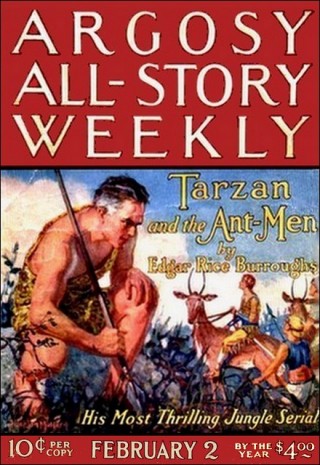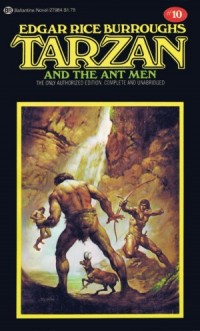 Tarzan and the Ant Men is considered by
many to be the pinnacle of the Burroughs Tarzan books with the author’s
vivid imagination and creativity going on full thrusters, but I myself
find some of the books societal implications a little troubling. Then
again it’s also basically a Tarzan meets Gulliver’s Travels story, and that’s kind of cool.
Tarzan and the Ant Men is considered by
many to be the pinnacle of the Burroughs Tarzan books with the author’s
vivid imagination and creativity going on full thrusters, but I myself
find some of the books societal implications a little troubling. Then
again it’s also basically a Tarzan meets Gulliver’s Travels story, and that’s kind of cool.First published as a seven-part serial in the magazine Argosy All-Story Weekly in 1924 this is entry can be considered the last book of the run that began with Tarzan the Untamed, continued through Tarzan the Terrible and Tarzan and the Golden Lion, and then concluded here with Tarzan and the Ant Men. After this most of the regular supporting characters begin to fade into the background, and Tarzan spends much of his time out in the jungle meeting new and interesting characters.
This exciting chapter in Tarzan’s life begins with the Ape Man insisting that he is ready for a solo flight in an airplane. His son Korak has been giving him flying lesson, and despite his son’s reservations about him being ready he takes off for a flight over the darkest jungles of Africa. If you believe something will go wrong, and that Tarzan will crash his plane over some lost city, give yourself a cookie. While flying low over jungle that Tarzan is unfamiliar with, which is apparently rare for him, his plane grazes a tree and he crashes. Tarzan, the king of the jungle, has entered an isolated country called Minuni. Cut off from the rest of the world by an immense thorn forest this lost civilization consists of two distinct races; the Zertalcolols who are a mute primitive race of large eared humans, and the Minunians, a people that are four times smaller than your average human, and who live in magnificent city-states that frequently wage war against each other. Tarzan first encounters a Zertalcolols female of the species when one finds his unconscious form after the crash. He is brought back the stone amphitheatre of the Alalus, where the Zertalcolols women and their families live. The females of the Zertalcolols are the dominate sex and the men are hunted solely for breeding purposes. The men are weak and timid while the women are violent and cruel, and they hunt the males with clubs and thrown pebbles. This is another instance where Burroughs views on women gets a bit dodgy, as he writes…
“The hideous life of the Alaus was the natural result of the unnatural reversal of sex dominance. It is the providence of the male to initiate love and by his masterfulness to inspire first respect, then admiration in the breast of the female he seeks to attract. Love itself developed after these other emotions. The gradually increasing ascendency of the female Alalus over the male eventually prevented the emotions of respect and admiration for the male from being aroused, with the result that love never developed.”
I’m guessing Burroughs wasn’t asked to speak at too many feminist luncheons. Then again this was the 1924 so there probably weren’t that many feminists groups around to picket him. Tarzan is the idolized version of the alpha male and Burroughs has clear views on where women belong next to such an example of the species. Later when Tarzan escapes these “awful” women he encounters an Alalus male and teaches him to make weapons and hunt for himself. Later we find out that the man Tarzan uplifted from sexual servitude has spread his skill and courage to other men, and has since struck back against the dominant women. Tarzan is known for showing up at some lost civilization and shaking things up, just in the previous book he had orchestrated the overthrowing of a race of gorillas that had enslaved men, but here he helps overthrow women. When the men defeat a group of women Tarzan’s pupil does a surprising thing, he doesn’t kill her but instead decides to keep her because he hates to cook.
“You will cook for me?” he demanded.
To his signs she but returned a sullen, snarling visage. The son of The First Woman raised his spear and with the heavy shaft struck the girl on the head, knocking her down, and he stood over her, himself snarling and scowling, menacing her with further punishment, while she cowered where she had fallen. He kicked her in the side.
“Get up!” he commanded.
Slowly she crawled to her knees and embracing his legs, gazed up into his face with an expression of doglike adulation and devotion.
“You will cook for me!” he demanded again.
“Forever!” she replied in the sign language of her people.
If you need to take a shower after reading that go head, I’ll wait until you get back.
Burroughs may have had many progressive views on religion and war but when it came to the Battle of the Sexes he was kind of a troglodyte. Now Tarzan is usually depicted as completely chivalrous, usually helping women whether they be his enemy or foe, but when Tarzan again encounters his pupil towards the end of the book he learns how things have changed.
"To entertain Tarzan and to show him what great strides civilization had taken in the land of the Zertalcolols, the son of The First Woman seized a female by the hair and dragging her to him struck her heavily about the head and face with his clenched fist, and the woman fell upon her knees and fondled his legs, looking wistfully into his face, her own glowing love and admiration."
Now it’s not clear what Tarzan’s stance is when comes to spousal abuse but the fact that he doesn’t pick this guy up, and toss him off a high cliff, kind of makes one wonder if this isn’t a bit of a peak into the mind of the author, and if so I pity Mrs. Burroughs. Lucky for us we do not spend the bulk of the book with this race of mute savages, but in the cities of the Minunians. While hunting for some food Tarzan encounters a horde of diminutive warriors, riding tiny antelope, battling an Alalu she. Tarzan spots one of the eighteen inch high warriors clutched in the she’s hand, and he signals her to release him. When she refuses Tarzan kills her with an arrow. Yeah, it seems Tarzan isn’t very chivalrous towards women in power. He had no knowledge of the situation he had blundered into, as a far as Tarzan knew that woman could have had every right to grab the little warrior. We’ll never know because he just outright murdered her.
Of course the person he rescued turns out to be the son of one of the Minuni kings. Tarzan is incredibly lucky when it comes to rescuing people; they are usually either royalty or at the very least the son or daughter of a local chieftain. Tarzan joins the Minunians on their trip back to the gigantic dome-houses in the city of Trohanadalmakus, while there he learns that the Minunian’s culture and its very existence hinges on the wars that allow a city-state to rejuvenate their gene pool by stealing slaves from their enemies. Tarzan finds himself fairly impressed with the soldiers of Trohanadalmakus and the society they protect.
"No chicanery of politics here, no thinly veiled ambition of some potential tyrant, no mad conception of harebrained dreamers, seized by the avaricious criminal for self-aggrandizement and riches; none of these, but patriotism of purest strain energized by the power of self-preservation. The perfect fighters, the perfect warriors, the perfect heroes these."
Burroughs clearly admires the men who go off to fight battles, but not so much the men who send them to fight for unjust or corrupt reasons. What is interesting to note here is that all the Minunian cities have slaves, but Tarzan never takes a stance on slavery itself. The part of Africa that he rules over he’s forbidden slavers to operate in, but he doesn’t seem to feel the need to oppose anti-slavery viewpoints anywhere else. Now if Tarzan himself is captured and enslaved he will of course free himself, and any slaves with him, but if the society that befriends him happens to have slaves he doesn’t like to make a fuss about it. He only helps the people of Trohanadalmakus against their enemies because he encountered them first. We of course later learn the king of the particular city is corrupt as well as mad, but once again Tarzan does not know this at first. Tarzan is a character who really likes to “wing it” in cases of morality. What Tarzan decides to do on a Tuesday, under the exact circumstances on a Wednesday, could lead to completely different actions. This kind of makes Tarzan a chaotic neutral character, which isn’t surprising as he’s a man of two worlds.
Tarzan and the Ant Men is a nice blend of jungle adventure and science fiction; Tarzan encounters a Lilliputian race that uses science to shrink him down to their size, while also spending time do his standard jungle fighting. Aside from the views of women, and how they should be treated, this is a solid adventure story, and a shrunken Tarzan fighting an army villainous despots is pure fun, but unfortunately the book occasionally leaves Tarzan and his exploits to see how Esteban Miranda, the Tarzan look-a-like from Tarzan and the Golden Lion. I was not a fan of that character when he first appeared and he does nothing here to change my mind. He has little to no impact on the main Tarzan’s story, the two only meet on the last page, and comes across as unnecessary padding. That Jane once again fails to recognize the imposter is a not so shining moment for her. It’s a times like this that one gets the impression Burroughs would have been happier if Jane had actually died in Tarzan the Terrible.


No comments:
Post a Comment